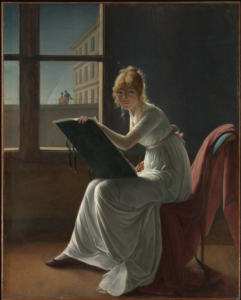They Said It Was A Masterpiece When They Thought A Man Had Painted It
Originally published by Sebastian Smee for the Washington Post
So much to love about this painting. The exquisitely simple white dress, for starters. (Who doesn’t love those radically pared-down, corset-free, high-waisted French Revolution-era dresses?) The contre jour lighting irradiating the sitter’s hair, her jawline and the outlines of her arms and legs while casting her face and most of her body in shadow. And then, too, the apparent mystery of the missing section of windowpane.
Beyond the window, we see a building, and a couple conversing by a balustrade. But aside from these minor details, the painting is calm, uncluttered, almost scrubbed clean. It’s spellbinding.
The picture’s minimalism, its rectilinear purity, sets off the sumptuous curves of the sitter’s body, the curved back of the chair and the shawl draped over it. It also provides a counterpoint to — or a container for — the charged intensity of the situation depicted: A young woman, an artist, has been interrupted at her work. She looks straight out at the viewer. Whatever she is working on is hidden, but she appears poised, ready to continue. (Notice her right hand down by her waist, presumably dipping her brush in ink.)
So immediate is the effect that you might wonder: Is she making an image of you?
Over the years, this remarkable painting has been ascribed to different artists. When the Met bought it in 1917, it thought it was purchasing a masterpiece by Jacques-Louis David (1748-1825), the most influential artist of the revolutionary era. It instantly became one of the Met’s most beloved and critically acclaimed works.
In fact, less than three decades later, art historians realized it couldn’t have been by David. (It was shown in an illustration of the 1801 Paris Salon, where David is known not to have exhibited any paintings.) At first it was attributed to a little-known female artist, Constance Charpentier. Eventually, experts concluded it must have been by Marie-Denise Villers.
Known to her friends and family as Nisa, Villers was the much younger sister of Marie Victorine Lemoine, herself an established and ambitious painter. She studied under Anne-Louis Girodet-Trioson and first exhibited at the Paris Salon in 1799. Two years later, this portrait was hung in a prominent place, a sign that it was highly esteemed.
The sitter is thought to be Charlotte du Val d’Ognes, a teenager who lived, as the art historian Anne Higonnet has shown, in the building visible through the window in this painting. Using great detective skills, Higonnet deduced that Villers has depicted a studio inside the Louvre — one of three such studios dedicated to female art students.
In a revelatory new book, “A Revolution on Canvas: The Rise of Women Artists in Britain and France, 1760-1830,” art historian Paris Spies-Gans has shown that female painters were much more prevalent in the revolutionary era (1760-1830) than previously thought. Aided by the ideals and social upheavals of the revolution, the period saw the rise of professional female artists on a scale that hasn’t been appreciated before.
These revolutionary-era women carved out professional careers, were taught by male artists (including David, who taught dozens of women) and, in turn, taught other women artists.
Viller’s painting later became, as Higonnet noted, “the poster child of the feminist art history movement” and was used on the cover of Germaine Greer’s 1979 feminist art history, “The Obstacle Race.” It deserves that status, no doubt. It also deserves to be admired as the masterpiece it was when it was acquired.
